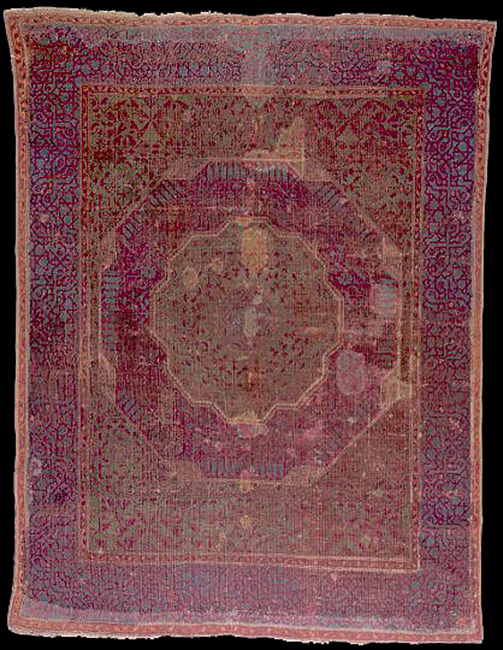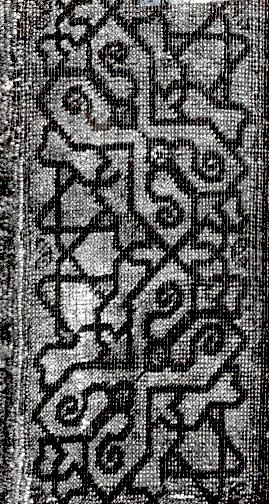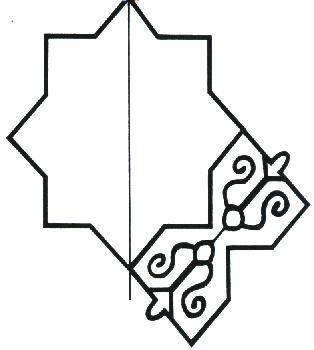|

THE JERREHIAN MAMLUK
by George O'Bannon
Recently while looking at the Jerrehian collection of
Oriental weavings, I came across a Mamluk rug. The border
pattern of the rug struck me as being different from
anything I had seen published. For that reason, it seemed
a worthy candidate for publication in Oriental Rug Review.
The article of Ms. Klose, which required a Mamluk
illustration, seemed the appropriate place to publish it.
The rug is not in the best condition, but rugs from the
l6th century rarely are. Several holes in the field of the
rug have also been rewoven; these date from different
times. The pile otherwise is as good as what one finds in
most museum Mamluks. Although thin, the depressed warps
have prevented erosion of areas of exposed warps and
wefts, so that the design is clear and visible.
The
colors are standard for the type: a cochineal red, an
abrashed blue generally in a mid-blue range, and a firm,
deep green. There is a minor use of a natural ivory.
The field design is dominated by a large octagon
medallion containing two smaller medallions. Most Mamluk
medallions are derived from a square-on-square or eight
pointed medallion. In some, as in this rug, the points
have been eliminated. A clear eight-point medallion is
found in the very center of this rug. The two horizontal
end panels in the field contain papyrus motifs and lancet
leaves. The closest to this rug in Cairene Rugs by Kuhnel
and Bellinger is Textile Museum R7.7, Plates 1 and XXI.

Fig.6. Section of the border |

Pairing of the half medallions
of the border results in an eight pointed Mamluk
medallion, drawing by Harold Elliott. |
The unusual feature of this rug is the border. It
initially appears to be a complex, geometric interlacing. The
most common Mamluk border is one with alternating roundel and
cartouche segments. Interlacing patterns are noted in Textile
Museum R7.7 and R7.16, Page II, Kuhnel/Bellinger. In both of
these rugs the patterns are the vegetal papyrus and leaf forms
found in the field as well.
The drawing here is decidedly
tile-like, seemingly composed of large and small segments.
Because our eye wants to find a pattern which can be
encompassed in its entirety, the main element appears to be an
hourglass shape tilted at a 45 degree angle. After studying
this rug carefully, it seems to me that the main pattern
consists of half eight-pointed stars in alternate right/left
repeats at the edge of the border (Figures 1 & 2). This
eight-pointed star appears in the center of the rug as well.
If one accepts this interpretation of the border, one can
then see a relationship to the subject rug presented by Ms.
Klose. The largest element in the border can be seen to be
based on the square-on-square medallion concept. If the dating
of this Mamluk to the beginning of the l6th century is
correct, it is a type which could have been contemporary to
the Geneva rug and served as a model. A link between Mamluk
rug patterns and those of the Ottoman period, as evidenced by
the Geneva rug and others such as the checkerboard and
Para-Mamluks, may be strengthened.
In addition to the
color illustration, Figure 3, a black and white photo taken
with a blue filter is presented in Figure 6, which shows more
clearly details of the design (Figure 3).
TECHNICAL
ANALYSIS
Warp: Ivory wool, Z2S, alternate warps
moderately depressed
Weft: Red wool, Z2S, two shoots
Knots: Asymmetric, open right, horizontal 12, vertical 10, 120
per square inch
Colors: GREEN, blue, red, ivory
Size: 5'
10"x4' 4"
Sides: Rewoven
Ends: Rewoven
|



